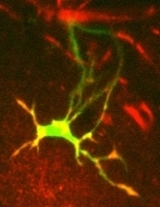Microglial repopulation model reveals a robust homeostatic process for replacing CNS myeloid cells.

Under most physiological circumstances, monocytes are excluded from parenchymal CNS tissues. When widespread monocyte entry occurs, their numbers decrease shortly after engraftment in the presence of microglia. However, some disease processes lead to focal and selective loss, or dysfunction, of microglia, and microglial senescence typifies the aged brain. In this regard, the long-term engraftment of monocytes in the microglia-depleted brain remains unknown. Here, we report a model in which a niche for myeloid cells was created through microglia depletion. We show that microglia-depleted brain regions of CD11b-HSVTK transgenic mice are repopulated with new Iba-1-positive cells within 2 wk.
The engrafted cells expressed high levels of CD45 and CCR2 and appeared in a wave-like pattern frequently associated with blood vessels, suggesting the engrafted cells were peripheral monocytes. Although two times more numerous and morphologically distinct from resident microglia up to 27 wk after initial engraftment, the overall distribution of the engrafted cells was remarkably similar to that of microglia. Two-photon in vivo imaging revealed that the engrafted myeloid cells extended their processes toward an ATP source and displayed intracellular calcium transients. Moreover, the engrafted cells migrated toward areas of kainic acid-induced neuronal death. These data provide evidence that circulating monocytes have the potential to occupy the adult CNS myeloid niche normally inhabited by microglia and identify a strong homeostatic drive to maintain the myeloid component in the mature brain.
For more details see:
Microglial repopulation model reveals a robust homeostatic process for replacing CNS myeloid cells
PNAS 2012; published ahead of print, Oct 15, 2012
Nicholas H. Varvel, Stefan A. Grathwohl, Frank Baumann, Christian Liebig, Andrea Bosch, Bianca Brawekc, Dietmar R. Thald, Israel F. Charoe, Frank L. Heppnerf, Adriano Aguzzig, Olga Garaschuk,Richard M. Ransohoffh, Mathias Jucker;
http://www.pnas.org/content/early/2012/10/10/1210150109.full.pdf+html?sid=2df2da89-359b-47d0-907f-16746e86f58b
- 72 views
